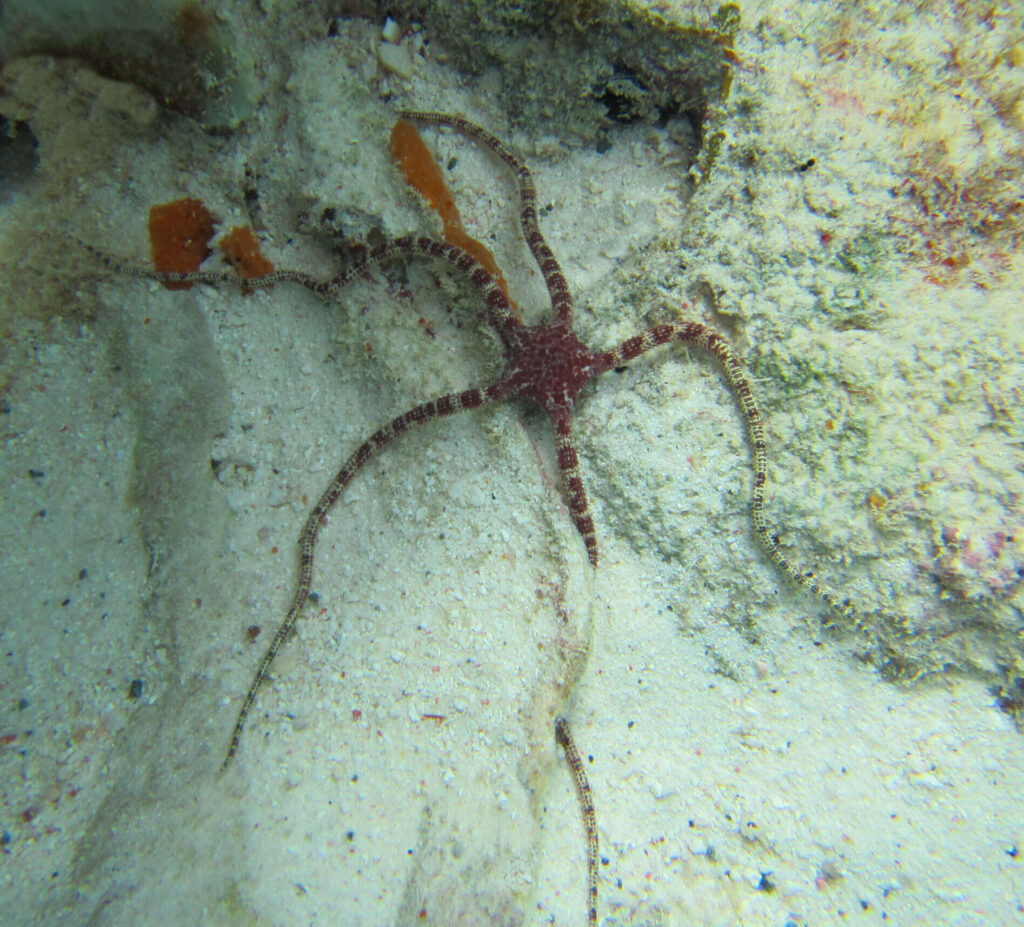Ruby Brittle Star, Ophioderma rubicundum
 Ruby Brittle Star, Ophioderma rubicundum. Underwater photograph taken in the coastal waters off Bonaire, Caribbean Netherlands, December, 2019. Photograph and identification courtesy of Bob Hillis, Ivins, Utah.
Ruby Brittle Star, Ophioderma rubicundum. Underwater photograph taken in the coastal waters off Bonaire, Caribbean Netherlands, December, 2019. Photograph and identification courtesy of Bob Hillis, Ivins, Utah.
Phylogeny: The Ruby Brittle Star, Ophioderma rubicundum (Lütken, 1856), is a member of the Ophiodermatidae Family of Brittle Stars that has two subfamilies, Ophiocominae and Ophiopsilinae that have four genera and one hundred twenty-seven species and one genera with thirty species, respectfully. The Ophiocoma Genus has seventy-seven known species. They are known in Mexico as Estrella Quebradiza Rubí.
Morphology: Ruby Brittle Stars have pentaradial symmetry. They have a flattened central disk and five arms. The arms are long, thin, and flexible. The arm tip is thin and tapered, nearly as high as broad. The arm spines are small and the lowest arm spine is much broader and longer than the dorsal spines. The arms have tube feet on their underside, but unlike the tube feet of sea stars, these feet lack suction cups. There is a mouth on the underside of the disk. The mouth consists of five “jaws”. Unlike sea stars, brittle stars cannot extend their stomach out though their mouth to digest prey externally. They use their arms and tube feet to pass prey into their mouth. Ruby Brittle Stars are highly mobile, using their arms to walk and climb. The arms are red, banded with brown, gray, and black. The disk is red, and sometimes marked with darker speckles or blotches. Rounded granules cover the disk, but the radial shields are usually smooth. Ruby Brittle Stars have disk of up to 2.3 cm (0.8 inches) in diameter. Their arms can reach 13.5 cm (5.3 inches) in length, though most specimens are much smaller.
Habitat and Distribution: Ruby Brittle Stars are usually found on rubble, reef, or algae bed habitats within the lower intertidal zone to depths up to 31 m (100 feet). Ruby Brittle Stars are a tropical Western Atlantic species that are found in all coastal Mexican waters of the Gulf of Mexico and the Caribbean.
Diet: Ruby Brittle Stars are opportunistic omnivores. They can feed as suspension feeders, using their arms to capture prey from the surrounding water, or as predators and scavengers. They prey upon carrion, coral spawn, crustaceans, detritus, diatoms, dinoflagellates, foraminifera, hydroids, mollusks and polychaetas.
Predators: There is limited documentation of predation on Ruby Brittle Stars. Known predators include various species of fish including cpufferfish, trunkfish, and wrasse.
Reproduction: Ruby Brittle Stars are gonochoric (male or female for life). They can reproduce sexually or asexually. In sexual reproduction, they engage in broadcast spawning, with external fertilization. The fertilized eggs turn into planktonic larvae that drift before settling on the ocean floor, where they mature into adult brittle stars. Asexual reproduction is accomplished through regeneration.
Ecosystem Interactions: Ruby Brittle Stars are a poorly studied and understood species. There is no documentation of their involvement in commensal, parasitic, or symbiotic relationships.
Human Interactions: Ruby Brittle Stars have no direct impact on human activities. From a conservation perspective they have not been formally evaluated however they are fairly common with a relatively wide distribution and should be consider to be of Least Concern.
Synonyms: Ophioderma rubicundra